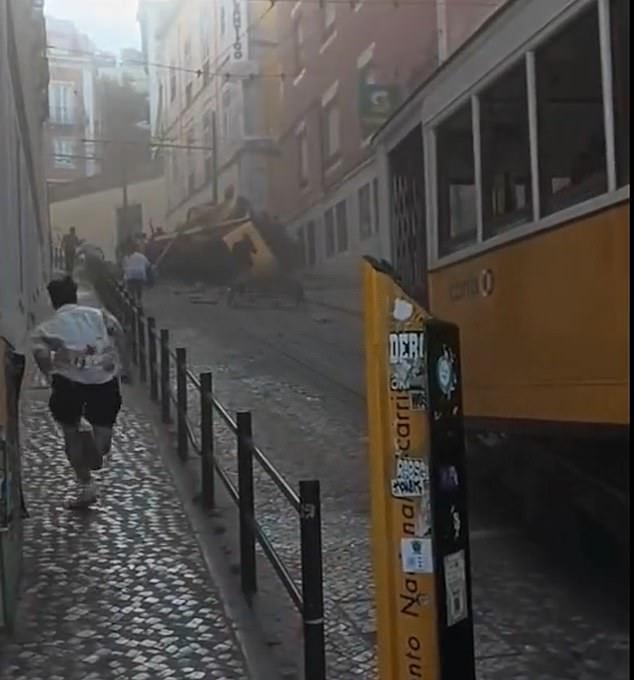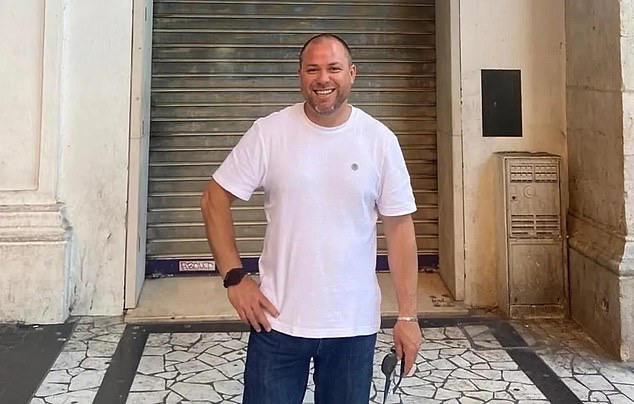A three-year-old German boy clung desperately to the police officer who rescued him from the mangled wreckage of Lisbon’s Gloria funicular, as his father lay dying beside him and his mother remained trapped with serious spinal injuries in Portugal’s worst transport disaster in recent memory.
The child, who suffered only minor injuries, has since been reunited with his critically injured mother in hospital following Wednesday evening’s catastrophic cable failure that sent the historic streetcar careening down a 17.7 per cent gradient before smashing into a building “like a cardboard box”.
André Jorge Gonçalves Marques, the brake guard operating the funicular, has been identified as the first victim of the tragedy that claimed 16 lives and left 23 injured when the iconic yellow carriage derailed at approximately 6:15pm during the evening rush hour near Avenida da Liberdade.
“His valour and professionalism, recognised by all, came to a tragic end with the loss of his life,” said Carris, the funicular’s operator, describing Mr Marques as a “dedicated, kind and happy professional, always willing to contribute to the greater good” after 15 years of loyal service.
The death toll climbed from 15 to 16 overnight as two critically injured passengers succumbed to their injuries at Hospital de São José, prompting Prime Minister Luís Montenegro to declare it “one of the biggest human tragedies of our recent history”.

Among the victims were at least four employees of Santa Casa da Misericórdia de Lisboa, Portugal’s largest charity which manages the Euromillions lottery games. The charity’s provedor, Paulo Sousa, confirmed in an internal memo that two staff members had died whilst seven others were hospitalised.
“Our colleagues were caught absolutely unexpectedly by this tragedy,” Mr Sousa wrote, noting that many employees regularly used the funicular to reach their offices near the Bairro Alto terminus.
The Lisbon Firefighters Regiment revealed that a cable detached from the funicular’s structure, causing the carriage to lose control on the steep cobbled street connecting Restauradores Square to the nightlife district.
It hit the building with brutal force and fell apart like a cardboard box,” witness Teresa d’Avó told Portuguese television channel SIC. “It was out of control, without brakes.”
Eyewitnesses described scenes of panic as the opposing cable car at the bottom of the 265-metre track jolted violently, with passengers leaping from windows as locals rushed to help those trapped in the wreckage amid plumes of smoke.
The 23 injured included nationals from Germany, Spain, France, Italy, Switzerland, Canada, South Korea, Morocco and Cape Verde, reflecting the funicular’s popularity with the 8.5 million tourists who visited Lisbon last year.
Fabiana Pavel, president of the Bairro Alto Residents’ Association, blamed “excessive tourism” for the tragedy, telling BBC Radio 4 that locals were often unable to use the railway “because it became a tourist attraction.
Transport union leader Manuel Leal revealed that Carris workers had “presented successive complaints” about maintenance issues, including problems with cable tension that made braking difficult. The union called for maintenance to be returned to in-house workers rather than outsourced to external companies.
The Elevador da Glória, designated a national monument and opened in 1885, can carry up to 43 passengers per car and transports approximately three million people annually. Its last general maintenance was conducted in 2022, with interim repairs completed in August 2024.
This marks the second incident on the line after a 2018 derailment caused by wheel maintenance flaws, though no one was killed in that accident.
Portugal observed a national day of mourning on Thursday, with President Marcelo Rebelo de Sousa cancelling the Belém Palace Book Festival and European Commission President Ursula von der Leyen expressing her sadness over the “famous Elevador da Glória” tragedy.
Lisbon Mayor Carlos Moedas immediately suspended operations of the city’s other three funiculars – Bica, Lavra and Graça – pending safety inspections, declaring three days of municipal mourning for what he called “a tragedy of the like we’ve never seen.
The prosecutor general’s office has opened a formal investigation, with the Office for Prevention and Investigation of Railway Accidents taking over technical analysis of the site where the yellow-and-white carriage lay crumpled against the building it struck after overshooting a sharp bend.
Engineering expert Fernando Nunes da Silva, a former Lisbon City Council member, said initial evidence pointed to a broken traction cable. “When that cable broke, the brakes that should normally work in a situation like this did not work,” he told SIC Notícias.
Emergency crews freed all trapped passengers within two hours, with rescue operations concluding by 8:30pm as forensic teams worked through the night conducting autopsies on the victims.
The tragedy has reignited concerns about Portugal’s tourism boom, with critics arguing that popular attractions are being pushed beyond capacity whilst maintenance standards potentially suffer under outsourcing arrangements introduced in 2011.
Follow for more updates on Britannia Daily



